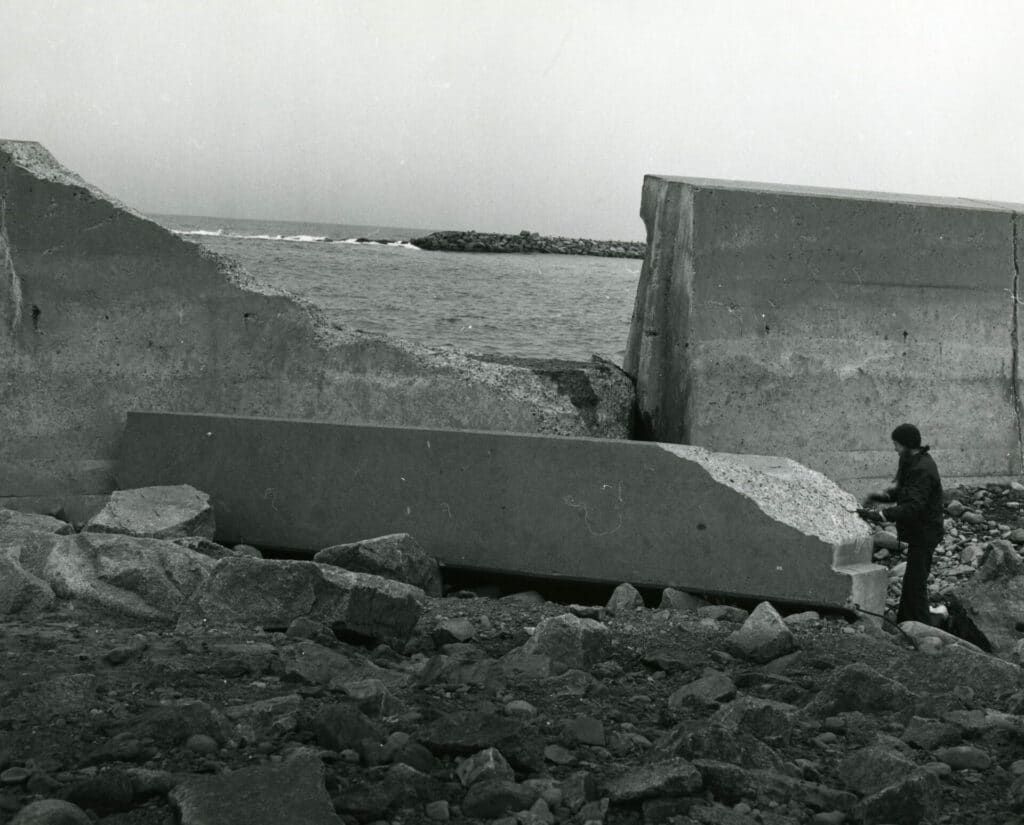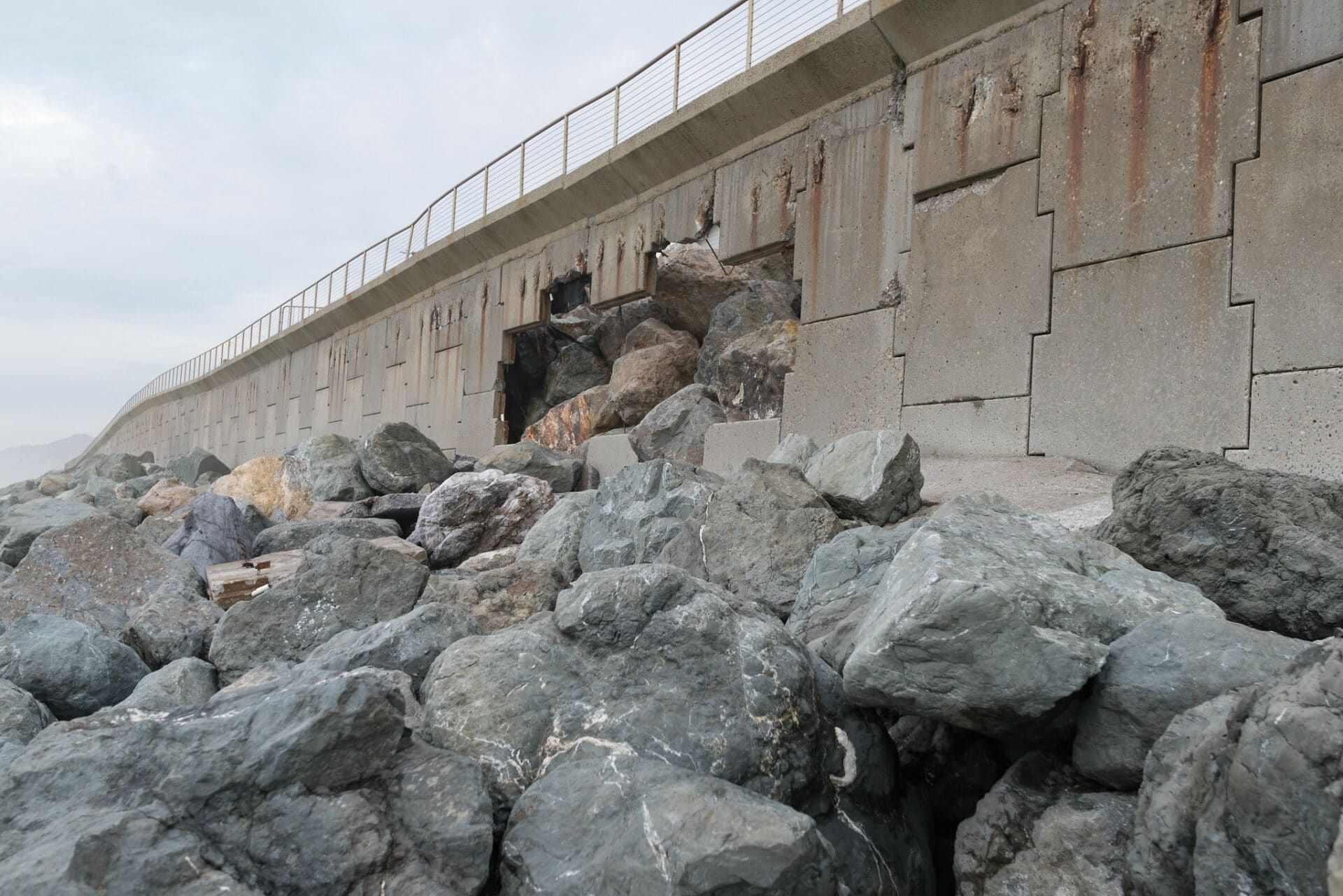Why cities should ditch seawalls and let the water in
By Kristina Hill | May 13, 2022
 A broken part of the seawall at Gun Rock Beach damaged in the Blizzard of 1978. (Photo: US Department of Defense)
A broken part of the seawall at Gun Rock Beach damaged in the Blizzard of 1978. (Photo: US Department of Defense)
An older generation of seawalls is in decay, while sea levels are rising around the world. Cities like New York, Seattle, and San Francisco are promoting expensive new seawall projects as having short-term and long-term benefits. But billion-dollar seawalls often won’t be an affordable long-term answer to rising seas, and better alternatives—including urban districts designed to float—are available for cities and countries willing to design for high and rising water.
Seawalls don’t work the way many of us think they do. Most existing seawalls were built to contain and stabilize a flat terrace of urban fill to allow boats to dock in deeper water. They weren’t built to hold back an increasingly energetic ocean. Nineteenth century cities washed sand down from their hills, added refuse, and filled up wharf districts where Clipper ships could pull up alongside piers. Those seawalls act like a belt holding in a belly, stabilizing soft soils to support building foundations and underground infrastructure. Blocking out temporary flooding caused by a storm was a helpful side effect, valuable in a past era when high water would recede again.
The archaeological record shows that seawalls that were built to protect against the rising ocean didn’t work for long. Seven thousand years ago, people carried large limestone blocks from more than a mile away to build a double-wall structure on the eastern Mediterranean coast, off the coast of current-day Israel, that was intended to keep the swash of waves from reaching higher ground—the first known seawall. Archaeologists think that a last gasp of rapid sea level rise pushed waves up to 8 inches higher in 30 years. For people living on a relatively flat terrace of land, the effects would have been devastating. That first seawall was overwhelmed in a lifetime or two, according to the archaeological evidence, and is now under six feet of seawater. Recent erosion of the sand that covered it for thousands of years has revealed that our ancestors’ seawall strategy failed. People moved to higher (and higher) ground.
This Stone Age wall did have one advantage over today’s seawalls, which is that it used modular construction. Blocks of stone piled up into walls can be moved and re-used. Today’s walls don’t have that flexibility. Instead, they are built with a monolithic design: concrete is poured over steel rods to form reinforced slabs and then, in the best cases, locked into a reinforcing platform with massive foundations that are proportional to the height of the slabs. In the flimsiest designs, the concrete slabs are just a facing material for a set of wooden posts, sometimes combined with a berm of rocks. These walls can’t be pulled apart and re-used as the sea continues to rise at an accelerating pace. Concrete seawalls supported by foundations all share this critical strategic flaw. Walls built with foundations proportional to their height can’t be raised without tearing out and replacing both the foundations and the concrete facing—a monumental, and expensive, undertaking.

Removing a deep wall is like pulling a rotten tooth; for city residents, it can be painful, complicated, and time consuming. Since a contemporary seawall provides no re-usable materials, investment in seawalls represent a liability for future generations. Sea levels will continue to rise, and today’s children will have to pay for them three times, first to build them, then to remove them, and finally to replace them. If cities and countries pass the original financing costs on to future generations by using long payback periods on municipal bonds to reduce the short-term costs, future generations may find that they have fewer options for adaptation. They could still be paying off debt from the original seawalls when new ones are needed.
Building seawalls in new places brings additional problems. Most existing walls now sit where cities already filled their old marshes and beaches. Building a new wall on a sandy or marshy shore guarantees that the wall will reflect waves, chewing away the marsh or beach, and eventually eroding its own foundations. Birds, fish, and shellfish will disappear with the marshes. Even so-called “living seawalls” are just textured concrete that is applied to the concrete slabs in the hope that shellfish may anchor on them, perhaps allowing larger fish to use them as a corridor to reach livable habitat on either side. They’re not living ecosystems where fish and crabs can reproduce as they would in a tidal mudflat, marsh, beach, or dune system. The plain fact is that extensive new seawalls would remove habitat for almost all of the wildlife and plants that make up coastal ecosystems.
Walls also deflect tidal surges towards either end, increasing the risk of flooding for neighboring communities that couldn’t afford to build a wall, or chose to keep their marshes. Quickly, walls beget more walls. Large cities can afford to spend billions to replace existing seawalls because they support buildings and infrastructure that are worth far more. Cities that don’t have seawalls yet will seriously consider adding them.
What’s the alternative? One option is to live with permanently higher water. Dutch cities have begun to diversify their strategies, using floating urban districts with flexible infrastructure at moderate densities, between 25 – 70 homes per acre. Japanese engineers built a full-scale floating airport runway as a demonstration. A 300-room hotel floats at the Victoria Docks in London, and Rotterdam has excavated artificial ponds that can store excess stormwater while providing a serene setting for upscale homes with water views. The lake around the expensive new homes also protects older parts of the city. Some Japanese cities with earthquake risks have built extra-wide levees known as super-dikes. These levees are so robust that roads and mid-rise buildings can be built on top, recapturing some of the cost. These are all ways of adapting in place, without having to retreat.
The climate crisis means that living with permanently higher water is inevitable. Most coastal engineers, on the other hand, have been trained to design temporary barriers for floodwaters that recede, for example, after a hurricane. Conventional floodwalls may not work because higher sea levels will never recede. Cities and countries should avoid the catastrophic failures that result from under-maintained walls, like the canal walls of New Orleans that broke and allowed flooding to overwhelm the city in seconds during Hurricane Katrina. Adaptation investments must be a legacy for the next generation, not a liability. Learning to live with higher water is a legacy worth passing on.
Together, we make the world safer.
The Bulletin elevates expert voices above the noise. But as an independent nonprofit organization, our operations depend on the support of readers like you. Help us continue to deliver quality journalism that holds leaders accountable. Your support of our work at any level is important. In return, we promise our coverage will be understandable, influential, vigilant, solution-oriented, and fair-minded. Together we can make a difference.
Keywords: cities and climate change, climate adaptation, climate crisis, sea level adaptation, sea level rise, seawalls
Topics: Climate Change, Opinion
















There is the obvious solution–build newer buildings with higher first floors with raised streets or move inland. Because building lifetimes are a century or less, it is a perfectly workable solution. Seawalls reflect short-term financial interests where want public money to protect dumb decisions–another form of bailout.
Thank you to Professor Hill and the Bulletin for this level-headed thinking.
The way to adjust to the effects of global warming is not to assume that they can everywhere be held at bay. So many battlelines will fail. Here as elsewhere, we need policies of accommodation, not confrontation.
Homo sapiens has endured for 300,000 years by retreating as well as advancing. Let’s continue our oldest tradition, and avoid allowing stress and distress to dictate exercises in futility.